Abstract
For a modern education, we are looking for new methods and means of achieving the instructional-educational process. For this, we do not have to wait for the change, but we need to get involved in this process. Students must be encouraged to have the freedom of thought and expression, and the school must provide the necessary conditions for the development of these abilities. Teachers can get information about different methods applied by the educational alternatives which have been widespread and appreciated in recent years. The purpose of this article is to establish the physical education teachers’ opinions regarding the implementation of some principles of the Step-by-Step alternative pedagogy. To get relevant results for this theme, the research method used was a face-to-face questionnaire, as well as an online variant managed through Google Forms. Participants in this study are teachers of physical education and sports in the pre-university education system, both in urban and rural areas. The results of this study offer new solutions and perspectives on the traditional system, and also relevant information on the implementation of some principles of the Step-by-Step alternative pedagogy: the advantages and disadvantages of implementing alternative pedagogy, the availability of teachers’ participation in training programs or the involvement of parents in school and extracurricular activities. The conclusions of our study reveal new directions in approaching the physical education and sports lesson by providing teachers with information about the principles of the Step-by-Step alternative pedagogy.
Keywords: Step by Stepprinciplesphysical education teachers
Introduction
The emergence of alternative educational programs, alternative textbooks, especially in the primary school system, but also at other levels, was a genuine didactic revolution in terms of teaching, learning and evaluation. New perspectives have been opened in the activities with students, the teacher’s relationship with students, with their parents, and all the elements involved in achieving high performance standards in terms of the education system.
Traditional and alternative education must operate complementarily due to the multitude of principles, methods and means that can be transferred in order to achieve performance in education. The study was aimed at improving knowledge on alternative programs. By using their attributes, we can develop a new didactic vision able to guide the education of the new generations. Also, by orienting the educational process towards the student’s needs, an increase in motivation can be gained for an active and creative participation of an individual in his/her own training process.
Problem Statement
The phrase “alternative education” describes different approaches to the instructional-educational process, other than the traditional education provided by the traditional system. Recovered in the form of public or private schools, alternative education has a special, often innovative curriculum, as well as a flexible study program geared to the student’s interests and needs (Aron, 2003). Broadly speaking, “alternative education” covers all educational activities that do not fit into the traditional school system and which add something to the proposed alternative models. Included in this category are special programs to combat school dropout, educate gifted students or for home care.
Alternative programs have become widely known for their mission to educate students who are at risk of failure within a public education system (Lehr, Tan, & Ysseldyke, 2009). Although these alternative pedagogical methods have existed for many years, there is very little evidence to show their efficiency or the understanding of their characteristics. However, many teachers believe that these alternative pedagogy methods can meet the needs of students. (Lange & Sletten, 2002)
The Step-by-Step system was initially a program aimed at improving learning abilities, social skills and the health of poor children, so that they can start school like their more advanced colleagues (Cunie & Thomas, 1993).
Given the different concepts used in teaching and learning, it is easier to describe what an alternative school teacher is not. Because all alternative education methods are learner-focused, teachers are never seen as mere agents of curriculum delivery. With varying degrees of intervention, the role of the teacher ranges from being an organizer and coach to the position of manager in learning environments. (Sliwka, 2008) The student’s greatest progress occurs when teachers facilitate the achievement of student learning objectives while favouring their development process (Collins, 2006).
From the curriculum point of view, the aim is to improve school education by setting tasks tailored to age specificities, such as language and literacy or cognitive and social-emotional development. The importance of the learning environment and the teacher-student relationship are also emphasised. (Puma et al., 2012)
The analysis of the literature on the use of grades in assessing students’ competences highlights that they have a positive effect only to the extent that other variants are not available (Lipnevich & Smith, 2009). The descriptive feedback used instead of grades or scores favours better academic performance (Black & Wiliam, 2003).
Teachers cannot teach content that they do not know. Therefore, studies reveal that teachers engage in activities involving the use of alternative methods to improve the motor potential of students who have participated in specific training programs (Lloyd & Modlin, 2012). This approach was the first to be used in the “I am moving, I am learning” program for obesity prevention, an activity carried out in Head Start schools, the precursor of Step by Step.
Research Questions
Our research study is outlined by the following research questions:
How informed are physical education and sports teachers about the Step-by-Step alternative pedagogy?
What are the prospects for implementing the Step-by-Step principles in physical education and sports lessons?
What is the influence of seniority in the department, the didactic levels of certification and the teacher’s gender on the opinions regarding the implementation of the Step-by-Step pedagogical method?
Purpose of the Study
The purpose of this article is to establish the physical education teachers’ opinions regarding the implementation of some principles of the Step-by-Step alternative pedagogy.
Research Methods
To obtain relevant information on the different ways of implementing the Step-by-Step principles in physical education and sports, specialised teachers were invited to fill in a questionnaire. It was applied in printed and online versions and addressed both traditional teachers and those teaching physical education and sports to alternative training classrooms. In our analysis, the subjects were protected by anonymity.
The evaluation tool contained 12 questions:
Q1. Do you know about the learning-pedagogical features of the Step-by-Step alternative method? Q2. Does your school have such alternative pedagogical methods? Q3. To what extent do you think that such an alternative method can increase student involvement in physical education and sports lessons? Q4. Being a physical education and sports teacher, would you consider it appropriate to implement the methods and means of the Step-by-Step alternative pedagogy in your lesson? Q5. What do you think would be the advantages for which you would opt to implement the methods and tools of the Step-by-Step pedagogical method? Q6. What do you think would be the disadvantages for which you would not opt to implement the methods and means of the Step-by-Step method? Q7. As a teacher, would you agree to participate in educational programs specific to the Step-by-Step pedagogical method? Q8. Do you think that the use of the principles and particularities of alternative pedagogies in physical education and sports lessons would favour the attractiveness of the didactic process? Q9. In the physical education and sports lesson, do you think there should be two teachers? Q10. To what extent do you agree that assessment in primary education should be done with the help of proficiency books, without grades? Q11. Does the involvement of parents in school and extracurricular activities help increase the attractiveness of the teaching process and the harmonious development of children? Q12. What do you think will be the effects of implementing the principles and methods of the Step-by-Step alternative pedagogy in the physical and sports education lesson?
The participants in this study were 103 physical education and sports teachers in the pre-university education system. Of these, 93 were teachers in traditional schools, and 10 in schools using the Step-by-Step method. In terms of gender distribution, the research included 44 women and 59 men.
Regarding their professional experience, 25 respondents have between 1-5 years of seniority, 17 between 5-10 years, 31 between 10-20 years, 22 between 20-30 years and 8 over 30 years of experience.
Their distribution, according to the didactic level of certification, is as follows: 28 respondents have full professional level, 23 hold level II of certification, 30 hold level I of certification, 5 have PhDs, and 17 respondents have no teaching certification.
Findings
Starting from the idea of identifying teachers’ views on the possibility of implementing some principles in physical education and sports lessons, we will present the results of our research.
Thus, 40.78% of the interviewed teachers are aware of the Step-by-Step alternative, while more than half, 59.22%, are unaware of data regarding the specific characteristics of the Step-by-Step educational alternative in terms of teaching and learning (Figure
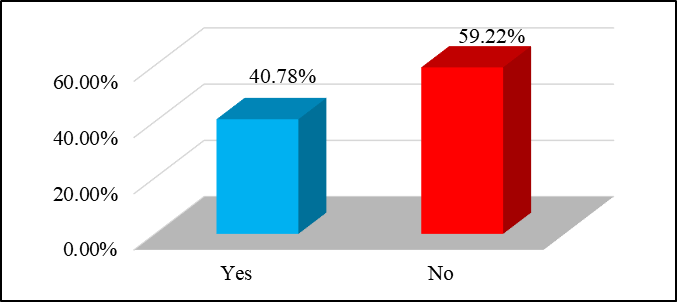
Out of the 103 teachers, 14.56% work in schools where the Step-by-Step alternative pedagogical method is operational, and 85.44% have mentioned that there is no alternative pedagogical method in their schools, which means that they are part of the traditional system of education. Of the 14.56% respondents, 10% teach in Step-by-Step schools, and the rest are teachers in traditional schools where there are Step-by-Step classrooms. (Q2)
In the opinion of teachers, the use of alternative pedagogical method principles in physical education and sports lessons could facilitate the increase of student involvement in physical education and sports lessons. A high percentage of 43.69% was recorded for the response “to a large extent”. A percentage of 16.50% said that their use could facilitate the increase of student involvement in the lesson “to a very large extent”, and 24.27% mentioned the response “neither to a small extent nor to a large extent”. (Figure
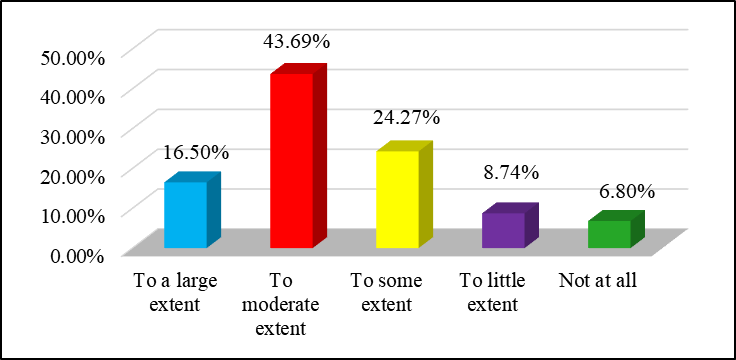
Regarding the benefits of implementing the methods and tools of the Step-by-Step pedagogical method in physical education and sports lessons, the emphasis on the development at one’s own pace is paramount, with 59.22% of respondents identifying it as the main advantage. Other benefits identified by half of the respondents: student-centred education, individualised education (57.28%) and the school-family partnerships, according to which active family involvement can lead to increased interest in physical activities (51.46%). The use of modern learning methods (49.51%), the elimination of subjectivism through evaluation without grades and the introduction of proficiency books (47.57%) are on the last places in the list. (Figure
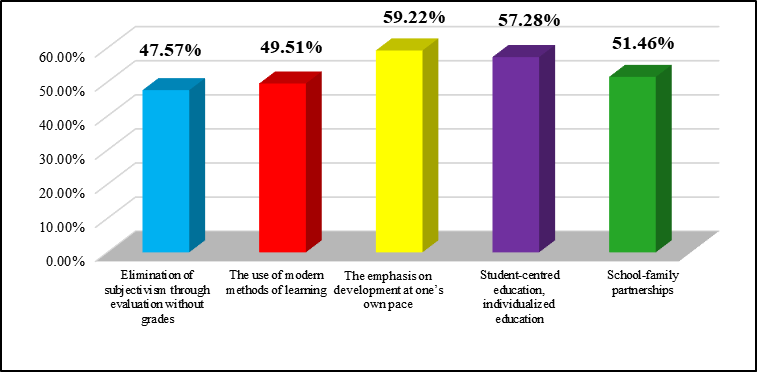
Regarding the difficulties that may arise in implementing the methods and means of the Step-by-Step pedagogical method in physical education and sports lessons, the lack of material resources in schools ranks first, 69.90% of respondents identifying it as the main disadvantage. Other responses highlight the teachers’ low level of information on the specific characteristics of the Step-by-Step method (63.11%), lack of interest or fear of leaving their “comfort zone” and trying something new (59.22%) and the high number of students for one teacher (50.49%). The last place is occupied by the emphasis on cooperation and less on competition (32.04%). (Figure
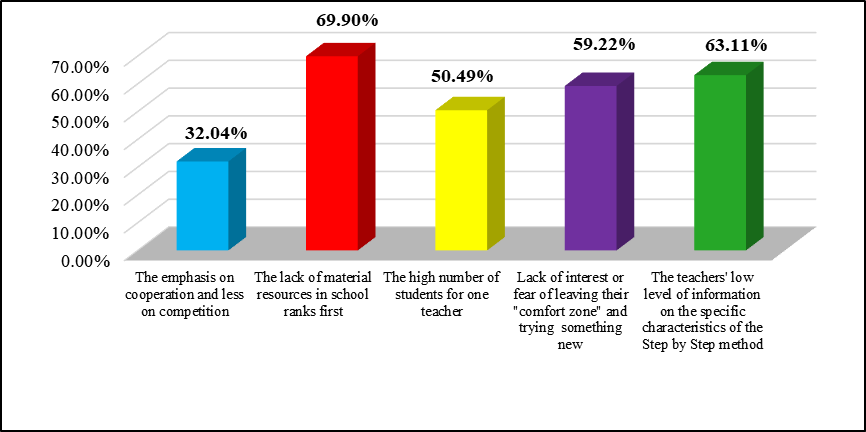
Questions 7 and 8 have high percentages for “to a large extent” and “to a very large extent”, indicating that teachers believe that this alternative pedagogical method could increase the attractiveness of the physical education and sports lesson and are willing to participate in training courses in Step-by-Step method (Table
At the question regarding the number of physical education and sports teachers in the lesson (Table
The partnership between family and school is very important, 42.72% and 31.07%, respectively, considering that the involvement of parents in both school and extracurricular activities can help tremendously (“to a large extent” and “to a very large extent”) to increase the attractiveness of the didactic process and the harmonious development of children (Table
Out of the 103 respondents, 78.65% consider it appropriate to implement the methods and means of the Step-by-Step alternative pedagogy in physical education and sports. There were high percentages for the partial agreement (40.78%) and total agreement (37.87%) levels (Table
Regarding the opinions of physical education and sports teachers on introducing assessment with the help of proficiency books, without grades, in primary education, the responses were favourable (Table
Regarding the effects that may occur in the implementation of principles and methods of the Step-by-Step alternative method in physical education and sports lessons, 58.25% of respondents think that it can help increase the attractiveness of lessons, and 45.63% that the individual’s ability to work in a team can be developed.
A percentage of 42.72% of respondents considered that an effect of the implementation would be the formation of the ability to practice physical exercise systematically and independently (Figure
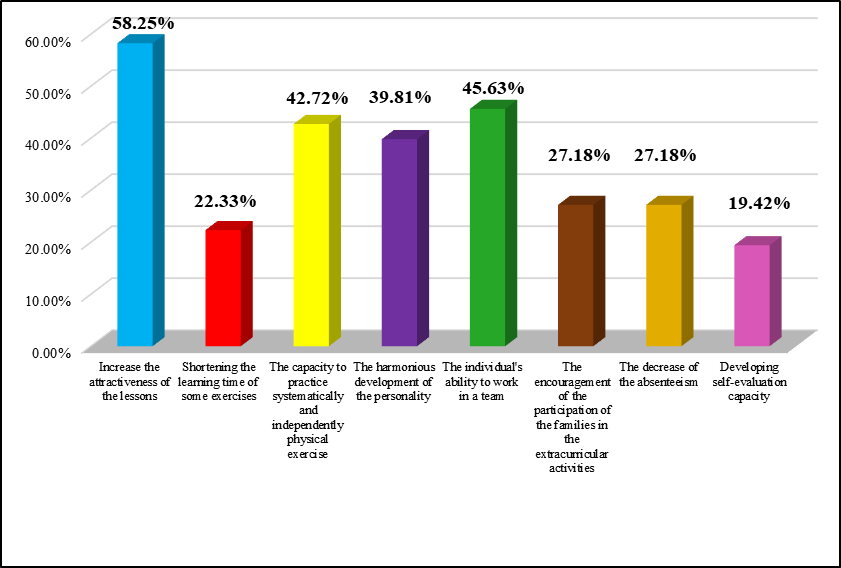
Conclusion
Recently, field specialists have noted that there are some differences between the traditional education system and the Step-by-Step pedagogical method, but there are also many common points, like the pursued goals or the use of the same curriculum. Both the common elements and the specific features indicate that the implementation of some principles of the Step-by-Step pedagogy in physical education and sports could be successful.
For a better understanding of the Step-by-Step pedagogy, it is suggested to promote it among both physical education and sport teachers and other teachers working in the traditional education area, regardless of their specialisation. Less than half of the respondents are aware of the particularities of alternative pedagogies, so training courses are needed in order to increase teachers’ receptivity to using educational alternatives in physical education and sports lessons.
This paper has established a number of advantages and drawbacks that result from the implementation of some principles of the Step-by-Step method. Regarding the benefits of implementing the methods and means of the Step-by-Step pedagogy in physical education and sports lessons, the focus on the development at one’s own pace is at the forefront, while the lack of material resources in schools is the main difficulty highlighted.
The implementation of some principles of the Step-by-Step method in the physical education and sports lesson could bring about benefits to the educational process, in particular by significantly increasing the attractiveness of the didactic process.
Acknowledgments
This paper is made and published under the aegis of the National University of Physical Education and Sports and is an extended version of the doctoral thesis conducted by the first author.
References
- Aron, L. Y. (2003). Towards a typology of alternative education programs: A compilation of elements from the literature. Washington DC: The Urban Institute.
- Black, P., & Wiliam, D. (2003). ‘In praise of educational research’: Formative assessment. British Educational Research Journal, 29(5), 623-637.
- Collins, A. (2006). Cognitive apprenticeship. In R. K. Sawyer (Ed.), Cambridge handbook of the learning sciences (pp. 47-60). Cambridge: Cambridge University Press.
- Cunie, J., & Thomas, D. (1993). Does head start make a difference? Cambridge: National Bureau of Economic Research. Retrieved from http://www.nber.org/papers/w4406.pdf
- Lange, C. M., & Sletten, S. J. (2002). Alternative education: A brief history and research synthesis. Alexandria: National Association of State Directors of Special Education. Retrieved from http://alternatyvusisugdymas.lt/uploads/2009/12/alternative_ed_history.pdf
- Lehr, C. A., Tan, C. S., & Ysseldyke, J. (2009). Alternative schools: A synthesis of state-level policy and research. Remedial and Special Education, 30(1), 19-32.
- Lipnevich, A. A., & Smith, J. K. (2009). Effects of differential feedback on students’ examination performance. Journal of Experimental Psychology: Applied, 15(4), 319-333.
- Lloyd, C. M., & Modlin, E. L. (2012). Coaching as a key component in teachers’ professional development: Improving classroom practices in Head Start settings. [OPRE Report 2012-4]. Washington, DC: Office of Planning, Research and Evaluation, Administration for Children and Families, US Department of Health and Human Services. Retrieved from https://www.acf.hhs.gov/sites/default/files/opre/coaching_key.pdf
- Puma, M., Bell, S., Cook, R., Heid, C., Broene, P., Jenkins, F., … Downer, J. (2012). Third grade follow-up to the Head Start Impact Study: Final report. [OPRE Report 2012-45]. Washington, DC: Office of Planning, Research and Evaluation, Administration for Children and Families, US Department of Health and Human Services. Retrieved from https://www.acf.hhs.gov/sites/default/files/opre/head_start_report.pdf
- Sliwka, A. (2008). The contribution of alternative education. In Innovating to learn, learning to innovate (pp. 93-112). Paris: OECD/CERI.
Copyright information

This work is licensed under a Creative Commons Attribution-NonCommercial-NoDerivatives 4.0 International License.
About this article
Publication Date
16 February 2019
Article Doi
eBook ISBN
978-1-80296-054-9
Publisher
Future Academy
Volume
55
Print ISBN (optional)
-
Edition Number
1st Edition
Pages
1-752
Subjects
Sports, sport science, physical education
Cite this article as:
Rusănescu, A., & Stoicescu, M. (2019). Step-By-Step Principles In Physical Education And Sports. In V. Grigore, M. Stănescu, M. Stoicescu, & L. Popescu (Eds.), Education and Sports Science in the 21st Century, vol 55. European Proceedings of Social and Behavioural Sciences (pp. 103-111). Future Academy. https://doi.org/10.15405/epsbs.2019.02.13
